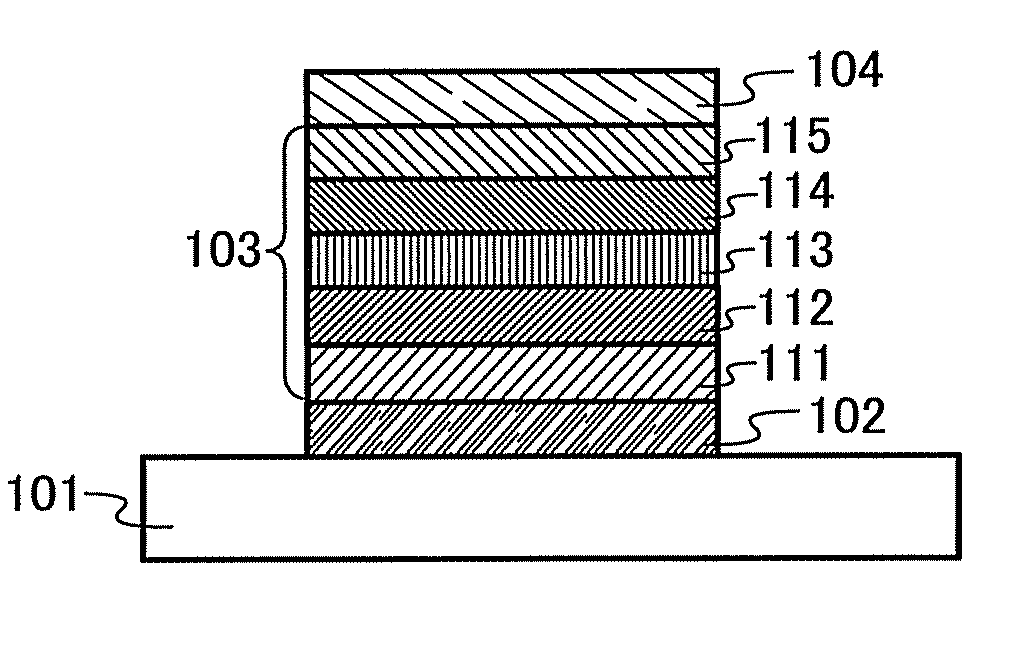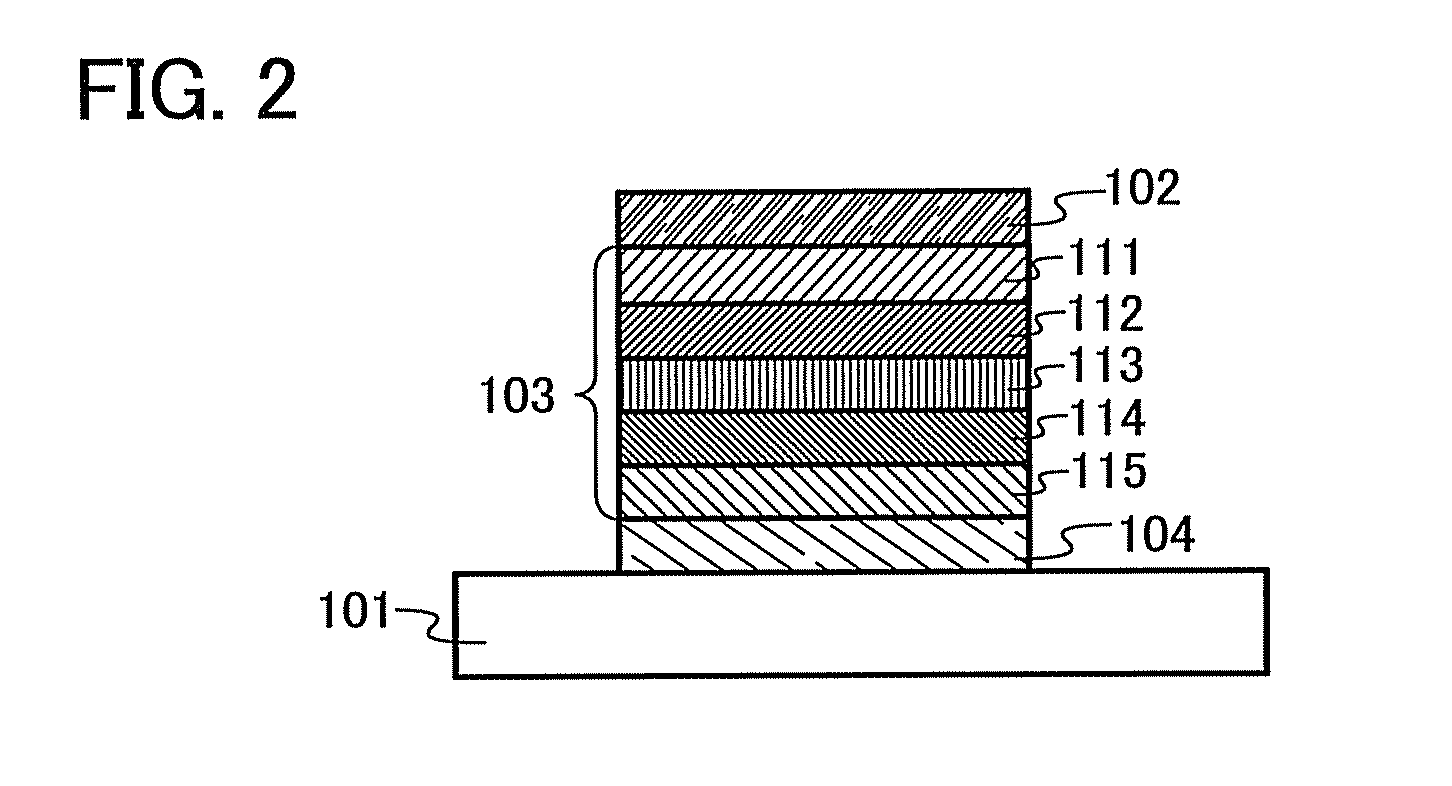Organic Semiconductor Material and Light-Emitting Element, Light-Emitting Device, Lighting System, and Electronic Device Using the Same
a light-emitting element and organic semiconductor technology, applied in the field of organic semiconductors, can solve the problems of reducing the luminous efficiency, affecting the emission efficiency of light-emitting elements, and the reduction of band gaps and triplet excitation energy, so as to reduce the driving voltage of light-emitting elements and reduce the power consumption of light-emitting elements. , the effect of reducing the power consumption of light-emitting elements
- Summary
- Abstract
- Description
- Claims
- Application Information
AI Technical Summary
Benefits of technology
Problems solved by technology
Method used
Image
Examples
embodiment 1
[0112]In Embodiment 1, an organic semiconductor material of an embodiment of the present invention will be described.
[0113]An organic semiconductor material of Embodiment 1 has a Z quaterphenylene skeleton ([1,1′:2′,1″:2″,1′″]quaterphenyl-4-4′″-diyl group). An electron-accepting unit is bonded to a para position of a terminal benzene ring of the Z quaterphenylene skeleton, and a hole-accepting unit is bonded to a para position of the other terminal benzene ring.
[0114]Specifically, the organic semiconductor material of Embodiment 1 is an organic semiconductor material represented by General Formula (G1).
[0115]In the formula, EA represents an electron-accepting unit, HA represents a hole-accepting unit, carbon of α1 and EA may be bonded to form a ring, and carbon of α2 and HA may be bonded to form a ring.
[0116]An organic semiconductor material having such a structure has an electron-accepting unit and a hole-accepting unit in its molecule, and thus is a bipolar material which can tran...
embodiment 2
[0153]In Embodiment 2, a benzoxazole derivative having the structure represented by General Formula (G1) will be described as an example of the organic semiconductor material of an embodiment of the present invention described in Embodiment 1.
[0154]A benzoxazole derivative according to Embodiment 2 is a benzoxazole derivative represented by General Formula (BOX1).
[0155]In the formula, Ar1 and Ar2 each independently represent a substituted or unsubstituted aryl group having 6 to 13 carbon atoms, and R1 to R4 each independently represent any of hydrogen, an alkyl group having 1 to 4 carbon atoms, an unsubstituted aryl group having 6 to 10 carbon atoms, or halogen. Ar1 and carbon of α, or Ar1 and Ar2 may be bonded directly or through sulfur, oxygen, or nitrogen.
[0156]The benzoxazole derivative according to Embodiment 2 is a benzoxazole derivative represented by General Formula (BOX2).
[0157]In the formula, R1 to R4 each independently represent any of hydrogen, an alkyl group having 1 to...
embodiment 3
[0189]In Embodiment 3, an oxadiazole derivative having the structure represented by General Formula (G1) will be described as an example of the organic semiconductor material of an embodiment of the present invention described in Embodiment 1.
[0190]An oxadiazole derivative of Embodiment 3 is an oxadiazole derivative represented by General Formula (OXD1).
[0191]In the formula, Ar11, Ar12, and Ar13 represent a substituted or unsubstituted aryl group having 6 to 13 carbon atoms. In addition, Ar11 and carbon of α, or Ar11 and Ar12 may be bonded to each other directly or through any of oxygen, sulfur, or nitrogen.
[0192]Further, the oxadiazole derivative of Embodiment 3 is preferably an oxadiazole derivative represented by General Formula (OXD2).
[0193]In the formula, R31 to R40 each independently represent any of hydrogen, an alkyl group having 1 to 4 carbon atoms, or an unsubstituted aryl group having 6 to 13 carbon atoms, and Ar13 represents a substituted or unsubstituted aryl group havi...
PUM
| Property | Measurement | Unit |
|---|---|---|
| internal quantum efficiency | aaaaa | aaaaa |
| internal quantum efficiency | aaaaa | aaaaa |
| ionization potential | aaaaa | aaaaa |
Abstract
Description
Claims
Application Information
 Login to View More
Login to View More - R&D
- Intellectual Property
- Life Sciences
- Materials
- Tech Scout
- Unparalleled Data Quality
- Higher Quality Content
- 60% Fewer Hallucinations
Browse by: Latest US Patents, China's latest patents, Technical Efficacy Thesaurus, Application Domain, Technology Topic, Popular Technical Reports.
© 2025 PatSnap. All rights reserved.Legal|Privacy policy|Modern Slavery Act Transparency Statement|Sitemap|About US| Contact US: help@patsnap.com



